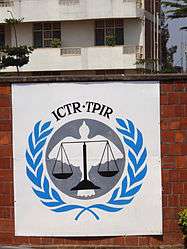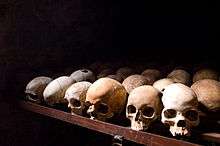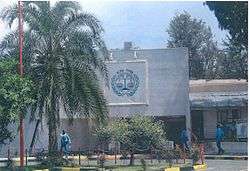International Criminal Tribunal for Rwanda
| International Criminal Tribunal for Rwanda (ICTR) | |
|---|---|
 | |
| Established | 8 November 1994 |
| Dissolved | 31 December 2015 |
| Country | Rwanda |
| Location | Arusha, Tanzania |
| Authorized by | United Nations Security Council Resolution 955 |
| No. of positions |
16 permanent 9 ad litem |
| Website |
www |
| President | |
| Currently | Vagn Joensen (Denmark) |
 Human skulls at the Nyamata Genocide Memorial Centre |
| Part of a series on the |
| Rwandan genocide |
|---|
|
Parties responsible |
|
Resources |
The International Criminal Tribunal for Rwanda[lower-alpha 1] (ICTR; French: Tribunal pénal international pour le Rwanda; Kinyarwanda: Urukiko Mpanabyaha Mpuzamahanga Rwashyiriweho u Rwanda) was an international court established in November 1994 by the United Nations Security Council in Resolution 955 in order to judge people responsible for the Rwandan genocide and other serious violations of international law in Rwanda, or by Rwandan citizens in nearby states, between 1 January and 31 December 1994.[1]
In 1995, it became located in Arusha, Tanzania, under Resolution 977.[2] (From 2006, Arusha also became the location of the African Court on Human and Peoples' Rights). In 1998 the operation of the tribunal was expanded in Resolution 1165.[3] Through several resolutions, the Security Council called on the tribunal to complete its investigations by end of 2004, complete all trial activities by end of 2008, and complete all work in 2012.[4]
The tribunal had jurisdiction over genocide, crimes against humanity, and violations of Common Article Three and Additional Protocol II of the Geneva Conventions (which deals with internal conflicts).
As of 2009, the tribunal had finished 50 trials and convicted 29 accused persons, and another 11 trials were in progress and 14 individuals were awaiting trial in detention; but the prosecutor intended to transfer 5 to national jurisdiction for trial. 13 others were still at large, some suspected to be dead.[5] The first trial, of Jean-Paul Akayesu, began in 1997. Jean Kambanda, interim Prime Minister, pleaded guilty. According to the ICTR's Completion Strategy, in accordance with Security Council Resolution 1503, all first-instance cases were to have completed trial by the end of 2008 (this date was later extended to the end of 2009[6]) and all work was to be completed by 2010. It had been discussed that these goals may not be realistic and were likely to change. The United Nations Security Council called upon the tribunal to finish its work by 31 December 2014 to prepare for its closure and transfer of its responsibilities to the International Residual Mechanism for Criminal Tribunals (IRMCT or Mechanism) which had begun functioning for the ICTR branch on 1 July 2012. As of spring 2015, the Residual Mechanism had taken over much of the operations of the tribunal, and the tribunal announced on February 2, 2015 that it was significantly reducing staff with the goal of wrapping up operations and closing the tribunal by the end of 2015.[7] The Tribunal was officially closed on 31 December 2015.
In March 2010, the ICTR announced plans to digitize all video recordings of the trials, both audio and video, in all three languages (English, French, Kinyarwanda). This was part of a larger project that included digitizing audio recordings.[8][9]
The Rwandan genocide
The Rwandan genocide refers to the mass slaughter of more than 800,000 ethnic Tutsi and politically moderate Hutu by government-directed gangs of Hutu extremist soldiers and police in Rwanda. The duration of the 1994 genocide is usually described as 100 days, beginning on April 6 and ending in mid-July.[10]
Tension between the majority Hutu and the minority Tutsi had developed over time but was particularly emphasized late in the nineteenth century and early in the twentieth century as a result of German and Belgian colonialism over Rwanda. The ethnic categorization of the two were an imposed and an arbitrary construct based more on physical characteristics than ethnic background. However, the social differences between the Hutu and the Tusi have traditionally allowed the Tutsi, with a strong pastoralist tradition, to gain social, economic, and political ascendancy over the Hutu, who were primarily agriculturalists.[10] The distinction under colonial powers allowed Tutsis to establish ruling power, until a Hutu revolution in 1959 abolished the Tutsi monarchy by 1961.
The hostility between the two groups continued, as “additional rounds of ethnic tension and violence flared periodically and led to mass killings of Tutsi in Rwanda, such as in 1963, 1967, and 1973.”[10] The establishment of the Rwandan Patriotic Front (RPF) and its invasion from Uganda furthered ethnic hatred. A ceasefire in these hostilities led to negotiations between the government and the RPF in 1992.[11]
On April 6, 1994 a plane carrying then President Juvenal Habyarimana, and Cyprien Ntaryamira of Burundi was shot down, killing everyone on board.[12] The Hutu held the RPF accountable, and immediately began the genocide, targeted at both Tutsis and Hutu moderates.
Most of the killing during the Rwandan genocide was carried out by the radical Hutu groups known as the Interahamwe and the Impuzamugambi.[13] Radio broadcasts also were an integral part of the genocide, which further fueled the genocide by encouraging Hutu civilians to kill their Tutsi neighbours, labeled as “cockroaches” in need of extermination.[10] Despite its colossal scale, particularly within such a short period of time, the genocide was carried out almost entirely by hand, usually with the utilization of machetes and clubs.[14] Various atrocities committed include the rape of thousands of Tutsi women, as well as the dismemberment and disfigurement of victims. Frequently the killers were people the victims knew personally—neighbours, workmates, former friends, sometimes even relatives through marriage.[14] At least 500,000 Tutsis were killed, and approximately 2 million refugees (mostly Hutus) left for refugee camps of neighboring Burundi, Tanzania, Uganda, and former Zaire.[13]
Establishment of the ICTR
The United Nations Assistance Mission for Rwanda is regarded as a major failure.[15] The international response to the Rwandan genocide was poor. For weeks, the major power nations denied that a genocide had taking place in Rwanda. The United States refused to call the incident "genocide" because using the term would make an obligation for the United States to send troops. Finally in July 1994, after the genocide was over, the UN Security Council called for an investigation of the events, and acted to establish an international criminal tribunal to prosecute those individuals most responsible for the genocide. Adopting Resolution 955, the Security Council created the ICTR on 8 November 1994 and the ICTR would also deal with other crimes against international humanitarian law committed on the territory of Rwanda and neighboring states between 1 January 1994 and 31 December 1994.[16]
ICTR Structure
The tribunal consisted of 16 judges in four "chambers" - three to hear trials, and one to hear appeals. In addition, there were 9 ad litem judges, making 25 in all. All 9 ad litem judges were assigned to Chambers II and III. There was an additional pool of 9 further ad literim judges who would be called on in the case of a judge being absent.
The column denoted by # indicates the order of precedence.
Trial Chamber I
| # | Judge | Nationality | Status |
|---|---|---|---|
| 19. | Mparany Rajohnson | Member (Ad litem judge) |
Trial Chamber II
| # | Judge | Nationality | Status |
|---|---|---|---|
| 4. | William Sekule | Presiding Judge | |
| 14. | Solomy Balungi Bossa | Member (Ad litem judge) | |
| 15. | Lee Gacugia Muthoga | Member (Ad litem judge) | |
| 16. | Seon Ki Park | Member (Ad litem judge) |
Trial Chamber III
| # | Judge | Nationality | Status |
|---|---|---|---|
| 1. | Vagn Joensen | President ICTR, Presiding Judge | |
| 2. | Florence Rita Arrey | Vice-President ICTR, Member | |
| 17. | Gberdao Gustave Kam | Member (Ad litem judge) | |
| 13. | Bakhtiyar R.Tuzmukhamedov | Member | |
| 18. | Robert Fremr | Member |
Appeals Chamber
| # | Judge | Nationality | Status |
|---|---|---|---|
| 3. | Theodor Meron | Presiding Judge | |
| 5. | Patrick Robinson | Member | |
| 7. | Fausto Pocar | Member | |
| 8. | Liu Daqun | Member | |
| 6. | Mehmet Güney | Member | |
| 11. | Carmel Agius | Member | |
| 9. | Arlette Ramaroson | Member | |
| 10. | Andrésia Vaz | Member | |
| 12. | Khalida Rashid Khan | Member |
Office of the Prosecutor

The Office of the Prosecutor was divided into two Sections:
- The Investigation Section was responsible for collecting evidence implicating individuals in crimes committed in Rwanda in 1994.
- The Prosecution Section was responsible for prosecuting all cases before the Tribunal.
Hassan Bubacar Jallow of the Gambia was the Chief of Prosecutions. He has previously served as the Gambian Attorney-General and Minister of Justice from 1984 to 1994, and subsequently as a Judge of Supreme Court of the Gambia from 1998 to 2002. He was appointed by the Security Council on September 15, 2003 to replace Carla Del Ponte from Switzerland. Her predecessor was Mohamed Chande Othman from Tanzania who served from 1998 to 2000.[17]
The Registry
The Registry was responsible for the overall administration and management of the ICTR. It also performed other legal functions assigned to it by the Tribunal’s Rules of Procedure and Evidence, and was the Tribunal’s channel of communication.
The Registry was headed by the Registrar, who was the Representative of the UN Secretary-General. Bongani Christopher Majola of South Africa was Registrar. after January 2013.
The Case of Jean-Paul Akayesu
After an intense and precisely targeted campaign of a number of international non-governmental organizations, which aimed at raising awareness of gendered violence at the ICTR,[18] the trial of Jean-Paul Akayesu established the legal precedent that genocidal rape falls within the act of genocide. "...the [Trial] Chamber finds that in most cases, the rapes of Tutsi women in Taba, were accompanied with the intent to kill those women. ... In this respect, it appears clearly to the chamber that the acts of rape and sexual violence, as other acts of serious bodily and mental harm committed against the Tutsi, reflected the determination to make Tutsi women suffer and to mutilate them even before killing them, the intent being to destroy the Tutsi group while inflicting acute suffering on its members in the process."[19] Presiding judge Navanethem Pillay said in a statement after the verdict: "From time immemorial, rape has been regarded as spoils of war. Now it will be considered a war crime. We want to send out a strong message that rape is no longer a trophy of war."[20]
The Case of Ferdinand Nahimana and Jean Bosco Barayagwiza
The trial against "hate media" began on 23 October 2000. It was charged with the prosecution of the media which encouraged the genocide of 1994.
On 19 August 2003, at the tribunal in Arusha, life sentences were requested for Ferdinand Nahimana, and Jean Bosco Barayagwiza, persons in charge for the Radio Télévision Libre des Mille Collines, as well as Hassan Ngeze, director and editor of the Kangura newspaper. They were charged with genocide, incitement to genocide, and crimes against humanity, before and during the period of the genocides of 1994. On 3 December 2003, the court found all three defendants guilty and sentenced Nahimana and Ngeze to life imprisonment and Barayagwiza to imprisonment for 35 years. On 28 November 2007, the Appeals Chamber partially allowed appeals against conviction from all three men, reducing their sentences to 30 years' imprisonment for Nahimana, 32 years' imprisonment for Barayagwiza and 35 years' imprisonment for Ngeze.[21]
No prosecutions have been brought against the founders, sponsors or anyone related to Radio Muhabura, a media whose pro-RPF messages were broadcast throughout the country during the 1990-1994 war.
Related legal activities
French investigating magistrate Jean-Louis Bruguière was also pursuing a case against the current President, Paul Kagame, and other members of his administration, for the assassination of his predecessor. This case was under the regular jurisdiction of the French courts because French citizens were also killed in the plane crash.
Indictees
The ICTR indicted a total of 96 individuals. Four individuals remain at large as fugitives and if captured they will be tried before the Mechanism for International Criminal Tribunals. The ICTR convicted 61 individuals: 32 of whom are currently serving sentences, 22 of whom have completed their sentences, and seven of whom died while serving their sentences. The Tribunal acquitted 14 individuals and transferred the cases against 10 individuals to national jurisdictions. The Tribunal ended proceedings against seven individuals before a final judgment was rendered: two of whom had their charges dismissed by the Tribunal, two of whom had their charges withdrawn by the Prosecutor, and three of whom died.
See also
Notes
- ↑ Full name: International Tribunal for the Prosecution of Persons Responsible for Genocide and Other Serious Violations of International Humanitarian Law Committed in the Territory of Rwanda and Rwandan Citizens Responsible for Genocide and Other Such Violations Committed in the Territory of Neighbouring States, between 1 January 1994 and 31 December 1994
References
- ↑ United Nations Security Council Resolution 955. S/RES/955(1994) 8 November 1994. Retrieved 2008-07-23.
- ↑ United Nations Security Council Resolution 977. S/RES/977(1995) 22 February 1995. Retrieved 2008-07-23.
- ↑ United Nations Security Council Resolution 1165. S/RES/1165(1998) 30 April 1998. Retrieved 2008-07-23.
- ↑ United Nations Security Council Resolution 1824. S/RES/1824(2008) page 1. 18 July 2008. Retrieved 2008-07-23.
- ↑ "Archived copy". Archived from the original on 2009-07-21. Retrieved 2010-04-13.
- ↑ Reuters (July 29, 2008)
- ↑
- ↑ "ICTR to Digitalize Court Proceedings," allafrica.com, 8 Mar 2010
- ↑ " ICTR to Digitize Video Recordings of its Trial Proceedings," ICTR website, 4 Mar 2010 Archived September 14, 2010, at the Wayback Machine.
- 1 2 3 4 "Rwanda Genocide of 1994". Encyclopedia Britannica. 5 August 2016. Retrieved 5 July 2017.
- ↑ "The Rwandan Genocide". History. 2009. Archived from the original on 2017-07-02. Retrieved 5 July 2017.
- ↑ "Rwanda Genocide: 100 days of slaughter". BBC News. 7 April 2014. Retrieved 5 July 2017.
- 1 2 "Rwandan Genocide". World Without Genocide. 21 February 2017. Retrieved 5 July 2017.
- 1 2 "1994: Rwanda"". Holocaust Memorial Day Trust. Retrieved 5 July 2017.
- ↑ "Rwanda/UN: Acknowledging Failure", AfricaFocus Bulletin (compiling several individual reports), March 31, 2004
- ↑ "International Criminal Tribunal For Rwanda (ICTR)," PiCT(Project on International Courts and Tribunals) 24 September 2013
- ↑ "The challenges of prosecuting and defending war criminals". The Irish Times. 2009-06-22. Archived from the original on 2018-08-08. Retrieved 2018-08-08.
- ↑ Klaus Bachmann, Thomas Sparrow-Botero, Peter Lambertz: When justice meets politics. Independence and Autonomy of ad hoc international criminal tribunals, Peter Lang Int 2013
- ↑ The Prosecutor v. Jean-Paul Akayesu (Trial Judgement), ICTR-96-4-T, International Criminal Tribunal for Rwanda (ICTR), 2 September 1998, p. 166 Archived 2012-10-12 at the Wayback Machine. ¶.733. Available at: http://www.unhcr.org/refworld/docid/40278fbb4.html [accessed 13 April 2010]
- ↑ Quoted in citation for honorary doctorate, Rhodes University, April 2005 accessed at "Archived copy". Archived from the original on 2008-10-01. Retrieved 2008-02-27. March 23, 2007
- ↑ Grunfeld, Fred; Anke Huijboom (2007). The Failure to Prevent Genocide in Rwanda: The Role of Bystanders. Brill. pp. 21–22. ISBN 978-9004157811.
- Jones, Adam (2010). "Genocide and Mass Violence". In Laura J. Shepherd. Gender Matters in Global Politics. Routledge. pp. 127–147. ISBN 978-0-203-86494-4.
External links
- International Center for Transitional Justice, Criminal Justice page
- TRIAL: Cases before ICTR
- Human Rights Watch Report, "Genocide in Rwanda"
- Topical digests of the case law of ICTR and ICTY, Human Rights Watch, 2004
- A case before the ICTR: Jean Kambanda - TRIAL WATCH
- Hirondelle News Agency, Arusha (English + French + Kinyarwanda + Swahili) covering the ICTR trials
- Voices of the Rwanda Tribunal - collection of interviews with tribunal members
- Introductory note by Michael P. Scharf and procedural history note on the Statute of the International Criminal Tribunal for Rwanda in the United Nations Audiovisual Library of International Law
